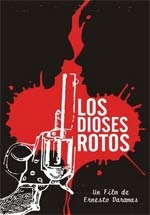 “Nuestro objetivo final es nada menos que lograr la integración del cine latinoamericano.
Así de simple, y así de desmesurado”.
“Nuestro objetivo final es nada menos que lograr la integración del cine latinoamericano.
Así de simple, y así de desmesurado”.
Gabriel García Márquez
Presidente (1927-2014)


-

Los dioses rotos, el mayor acontecimiento audiovisual en Cuba de los últimos tiemposPor Joel del RíoNunca descansan en paz las leyendas, cuando habitan el alma incombustible de una nación. Están condenadas a resucitar, una y otra vez, en los albores o en las postrimerías de cada siglo. Los dioses rotos, la película que dirigió y escribió Ernesto Daranas, se ha transformado en el mayor acontecimiento audiovisual en Cuba, desde que se estrenara en diciembre, porque verifica una suerte de recreación actualizada de los valores que representara Alberto Yarini, el proxeneta elevado a la categoría de ídolo popular, en la capital cubana a principios del siglo XX.
Como asegura al final de la película Laura, la profesora universitaria que «desciende» al infierno de la marginalidad cual cazadora que se adentra en la selva, a riesgo de ser devorada por los tigres, «como en un ciclo de inacabadas reencarnaciones, Alberto Yarini regresa una y otra vez para volver a ser coronado en San Isidro, Belén, Jesús María, Colón, Guanabacoa. Su poder de seducción encandiló el alma misma de una cultura que, a la par que lo cuestiona, lo venera. No deseo ser sacrílega (...) de hecho, yo también quisiera que fuera de otra manera». En esa ambigüedad entre la adoración por estos seres cuyo apasionamiento los lleva al abismo, y la racionalidad del intelectual que busca el conocimiento y la cordura, se mueve esta película apasionante, hermosísima, que ha rescatado para sí aquel calificativo de «tragedia griega a la cubana», endosado en su momento al teatral Réquiem por Yarini, de Carlos Felipe.
El primer, descomunal, acierto de Los dioses rotos, estriba en la presentación de una historia que atrapa al espectador desde los primeros minutos (con un montaje simultáneo de planos muy cortos, casi «videocliperos», el ejemplar manejo del material de archivo, y la sabia colocación de los puntos de giros, y de los elementos referenciales que nos permite entrar muy rápidamente en la película) y por supuesto, triunfa la revelación paulatina de personajes complejos, afacetados, gente atrapada en sus circunstancias y marcada por su destino adverso —como reclama cualquier tragedia que se respete— pero que ocupa una anómala, mas innegable, dimensión de la grandeza humana, signada por la generosidad, el altruismo y más que todo por la pasión, pasión entendida cual explosivo capaz de acabar con todo en derredor para tener cerca a ese único ser que acelera el pulso y trastorna la cabeza.
Los móviles de los protagonistas, incluidos los dos triángulos que concentran la principal acción dramática (Laura, Alberto y Sandra, constituyen un núcleo de conflicto y el otro lo forman Anselmo, Sandra y Alberto) pueden transitar las bajas pasiones, la mentira, el fingimiento, el comercio con intereses sexuales, la violencia y el delito, pero nunca la película se permite, por suerte, las conclusiones sociológicas de manual ni la moraleja condenatoria de obvia corrección política. El filme se mantiene fiel a la historia, al espléndido diseño de acciones y personajes, a las reglas del género escogido —se mueve entre el melodrama de sesgo verista con elementos de suspense, o de thriller erótico con vocación repartera— de modo que esta película está gobernada por la emotividad y el deseo de comprensión e identificación que promueve, más allá de los mil tópicos al uso respecto a las asimetrías sociales, los solares, la rudeza y la grosería, el folclorismo y el guaguancó, pintoresquistas y adyacentes.
Réquiem por Yarini no quiso adecuar su alcance estético a la ínfima calidad moral del mundo representado, y Los dioses rotos instaura también su condición de alta orfebrería en la puesta para reflexionar sobre actitudes y conductas usualmente condenadas. Tal vez, para conseguir el mayor empuje dramático y visual, se hermosearon en exceso la sordidez y la decadencia —acompañadas además por música incidental un tanto distanciadora—, a punto tal que por momentos el filme roza el mismo autoexotismo turístico que, en algún momento, le reprochan a Laura. Me refiero a los momentos en que se escuchan textos que tácitamente critican actitudes implícitas en palabras como «vienen a retratar la mierda y luego se van», o «si no sabes pa’qué te metes», que percute al final, cuando queda en claro que nadie puede sumergirse en el agua sin empaparse la ropa. A menos que te desnudes antes.
El coqueteo del filme con los métodos del documental (las entrevistas que aparecen sobre todo en la primera mitad, a muchachas dedicadas a la prostitución) si bien poseen eficacia dramática y referencial, pues permiten al personaje de Laura, y al espectador junto con ella, irse adentrando en la vida cotidiana de estas personas, refuerzan cierto aire de artificialidad y grandilocuencia que eligieron los hacedores de esta película con plena conciencia de causa. Si los referentes provienen posiblemente de Scorsese, Tarantino y Kar Wai, la publicidad y el videoclip, Amores perros y Ciudad de dios, Papeles secundarios y María Antonia, parece un giro estilístico demasiado prolijo ese costado supuestamente documental, pues las entrevistas aparecen tan actuadas, representadas y montadas como el resto de la película. Entonces, no se justifica del todo esa insistencia en el proceder testimonial, cuando los creadores de Los dioses rotos jamás pretendieron reforzar la tradición de naturalismo, cine directo y verosimilitud a ultranza que gobierna los documentales típicos sobre estos temas y personajes. Vale decir que las falsas entrevistas enriquecen el drama que la película presenta (como también lo consigue la banda sonora nada rumbera), y por lo regular apuntan subtramas que se imbrican muy coherentemente con la premisa del filme y con su fábula principal.
Muchos elogios ha merecido esta película, y entre los mayores están los aplausos conquistados por las actuaciones todas, principales y secundarias. Probablemente esta sea una de las películas cubanas con un nivel más alto y parejo de histrionismo. Se consagran categóricamente, Silvia Águila y Héctor Noas, la primera encarnando todos los matices de la duda, la conmiseración y el declive ético; el segundo, entregándonos a uno de los malvados más sugestivos y contenidos del cine cubano; Carlos Ever Fonseca y Ania Bu le confieren donaire, vehemencia y fotogenia a sus respectivos personajes, enormes retos en carreras que recién comienzan, y no debieran escaparse a esta mención la sempiterna corrección de Amarilys Núñez, la facilidad proverbial para decir textos incómodos de Mario Limonta, la presencia destacada de Isabel Santos y Patricio Wood, demostrando que esa generación de actores sigue luchando duro por permanecer entre los clásicos.
Cine profesional, espectacular, comprometido con la realidad, accesible a todos los espectadores, adulto estéticamente y conceptualmente rico, complejo, polémico, Los dioses rotos no se ve afectada mínimamente por el empleo de ciertos recursos narrativos y estilísticos procedentes de la televisión, el video musical, o incluso de la publicidad. Y apenas queda espacio para exaltar la eficacia del guión y de los diálogos, desde la introducción hasta el desenlace; la fluidez y el ritmo de la edición, el colorismo medio almodovariano y voluptuoso de la fotografía y la dirección de arte, que le proveen sangre, carácter y palpitación a la historia. No sería del todo honesto, y Los dioses rotos merece de la crítica la sinceridad equivalente a cada una de sus franquezas en secuencia, si no expreso que lo único que me molestó, al nivel de la clásica piedrecilla ínfima en el zapato, es la recurrencia machista de la trama. Aunque se pretende revelar, de alguna manera, los entresijos sicológicos del proxenetismo, y por tanto el machismo es un elemento más que necesario, imprescindible; a pesar de que las mujeres encarnen el principio activo de la acción y constituyan los móviles de la tragedia, el filme presenta solo antiheroínas que enloquecen con cada vibración de la portañuela adorada, seres cuya racionalidad enceguece por el deseo de venganza o por los celos, y a la hora del hembrismo y la progesterona desatada da lo mismo que seas universitaria o jinetera con baja escolaridad, porque el argumento te lanzará de cabeza a los pies del macho regente, siempre heroico, protector, generoso, incluso mártir. Puede ser que la película testimonie los rezagos de esa manera de relacionarse entre los sexos, y donde yo veo concupiscencia androcentrista, haya más bien voluntad de crítica y denuncia. Tal vez. Recordar que Laura, después de pasar por todas las estancias de la impureza, asegura que ella también quería que fuera de otra manera. Solo sugiero esa lectura posible y dejo la puerta abierta para que cada lector formule su punto de vista al respecto. En fin, corra a verla. Que el ICAIC ha encontrado la mejor manera de celebrar su aniversario 50.
 Los dioses rotos, the most important audiovisual event of the last times in Cuba
Los dioses rotos, the most important audiovisual event of the last times in Cuba
By Joel del Río
The legends, they never rest in peace, when they inhabit the everlasting soul of a nation. They are condemned to reborn, time after time, in the beginnings or in the twilights of every century. The feature film Los dioses rotos (broken gods in Spanish), by the Cuban Ernesto Daranas, has become the most important audiovisual event in Cuba since its release in December 2009, because it verifies a kind of up-to-date recreation of the values that represented Alberto Yarini, a pimp elevated to the category of popular idol, in the Cuban capital at the beginning of the 20th century.
As is stated at the end of the movie in words of Laura -a university teacher that "descends" to the hell of marginality, like a hunter who goes deep into in the forest, risking to be devoured by tigers- "like in a cycle of unfinished reincarnations, Alberto Yarini returns time after time to be crowned again in Havana’s places like San Isidro, Belén, Jesús María, Colón, Guanabacoa. His seduction power dazzled the very soul of a culture that questions and worships him at the same time. I do not want to be sacrilegious (...) in fact, I also wish that it would be not that way." In that ambiguity between the adoration of human beings whose passion leads them to the abyss, and the intellectual rationality that looks for the knowledge and good sense, moves this exciting, beautiful film that would well deserve the label of “Cuban-style Greek tragedy”, also endorsed at its moment to the theater play Réquiem por Yarini by Carlos Felipe.
The first, enormous achievement of Los dioses rotos, rests in the presentation of a story that entice the spectator from its first minutes (with a simultaneous montage of very short shots, almost as the one of the music videos, the excellent use of the archive footage, and the smart conception of the turning points and of the referential elements that allow us to quickly become part of the film), and of course there is also the triumph, of the gradual revelation of complex characters, revealed in facets, people caught in its circumstances and marked by its adverse destiny - as it is essential to any tragedy that respects itself- but who are part of an anomalous, but undeniable dimension of the human greatness, characterized by the generosity, the altruism and more than everything the passion, understood as an explosive ready to destroy everything around only to have at the reach of its hand the being that accelerates its pulse and causes craziness.
The motives of the main characters, included the two menage a troi that concentrate the main dramatic action (Laura, Alberto and Sandra, they constitute a conflict center and the other one Anselmo, Sandra and Alberto) can include the low passions, the lie, the feigning, the commerce with sexual interests, the violence and the crime, but the movie is never allowed, fortunately, the sociological conclusions of a manual neither the condemnatory moral of obvious political correctness. The film stays faithful to its story, to the splendid design of actions and characters, to the rules of the chosen gender -it moves from the melodrama with a realistic slant and suspense elements, or of erotic thriller with a neighborhood spirit kind of approach.- in a way that this movie is governed by the impulse and the wish of understanding and identification that it promotes, beyond the thousand topics in regard to social asymmetries, the dilapidated rooming houses, roughness, rudeness, folklore and the guaguancó African rhythm, all colorfull and of secondary importance.
Réquiem for Yarini, the play, did not want to adapt its aesthetic approach to the low moral quality of the world reflected, and Los dioses rotos, the film, also established its condition with a refine precious metal work-like mise en scene, set to meditate on attitudes and behaviors usually condemned. Perhaps, in order to get a bigger dramatic and visual impact, were excessively embellished the sordidness and decadence, accompanied by a little distancing incidental music, to such extent that at times the film touches the same tourist self-exoticism that in some moment is reproach to Laura. I refer to the moments in which texts are listened that tacitly criticize implicit attitudes in words like “they come to take their snapshots of the dirt and then leave", or "if you don't know about it why you get involved in it " a phrase that strikes at the end, when it is undoubtedly clear that nobody can dive into water without her/his clothes getting wet. Unless taking one´s clothes off before.
The flirtation of the film with the methods of the documentary (the interviews to girls dedicated to prostitution made mainly in the first part of the film) have a dramatic and referential effectiveness, because they allow Laura’s character and the spectator together with her to begin to get deeper into these people lives, but this flirtation reinforces certain artificiality and grandiloquence air that the makers of the film chose consciously. If the referents of this film possibly come from Scorsese, Tarantino, Kar Wai, the publicity and the music video, Amores perros and City of God, Papeles secundarios and María Antonia, it seems a too meticulous stylistic turn this supposedly documentary side of the film, since the interviews seem so much acted, dramatized and staged as the rest of the film.
Then, is not completely justified that insistence in testimonial methods, since the creators of Los dioses rotos never attempted to reinforce the tradition of naturalism, direct cinema and realism that governs the typical documentaries on these themes and characters. On the other hand, it is worth to say that the false interviews enrich the drama of the film (as do the soundtrack not related to the traditional Rumba music’s rhythm), and generally they contribute to sub-plots that are very cohesively inserted into the film premise and its main plot.
Many praises have deserved this movie, and the most important one are the applauses conquered by the ensemble of the performances of actor in leading or supporting roles. Probably this it is one of the Cuban movies with a higher and even level of histrionics. They are consecrated categorically, Silvia Águila y Héctor Noas, the first embodying all the nuance of the doubt, the commiseration and the ethical decline; the second, creating one of the most suggestive and self-controlled villain of the Cuban cinema; Carlos Ever Fonseca and Ania Bu confers charm, vehemence and photogenic quality to their respective characters, an enormous challenges in careers that just begin, should not stop from being mentioned the eternal correction of Amarilys Núñez’s performance, the proverbial easiness to tell uncomfortable texts of Mario Limonta, the outstanding Isabel Santos and Patricio Wood’s presence, demonstrating that their generation of actors continues fighting hard to take their place among the classics.
Professional, spectacular cinema, committed with reality, accessible to all the spectators, aesthetically adult and conceptually rich, complex, polemic, Los dioses rotos is not affected at all by the use of certain narrative and stylistic resources from television, the music video, or even publicity. There is barely enough space to praise the effectiveness of the screenplay and its dialogues, from its introduction until the denouement; the fluency and rhythm of the editing, the color closes to the one of Almodovar’s films and the voluptuousness of the cinematography and the art direction that provide temperament, spirit and emotion to the story.
I would not be completely honest -and Los dioses rotos deserves from the critic an equivalent sincerity to the frankness of each one of its sequence- if I do not express that the only thing that disturbed me, the unavoidable minimal disturbance that we customarily are oblige to mention, was the recurring male chauvinism of the plot. Although the film attempts to reveal, somehow the psychological details behind procurement, and therefore the male chauvinism is an element more than necessary, indispensable; and even when women embody the active principle of the action and constitutes the motives of the tragedy, the film presents only anti-heroine that go mad with each vibration of the adored fly, beings whose rationality is blinded by their desire of vengeance or jealousy, and at the moments of the “apotheosis of femininity” and uncontrolled progesterone secretion does not matter if a woman is a university graduate or a street hooker with a low lever of education, because the plot will throw us straight to the feet of the governing male, always heroic, protective, generous, even a martyr.
It could be that the film testifies the backwardness of the way in which the gender relate, and what I consider male centered concupiscence, be rather an attempt to critize and denounce it. This is a possibility. Just remember that Laura, after visiting all the rooms of impurity, assures that she also wanted that all would have been in a different way. I only suggest this possible reading and I leave an open door so that each reader formulates his point of view in this regard. In short, hurry up to see this film. The Cuban Institute of the Film Art and Industry (Instituto Cubano del Arte y la Industria Cinematográficos, ICAIC) has thought his release as the best way to celebrate it 50th anniversary.
(Fuente: Juventud Rebelde)
















